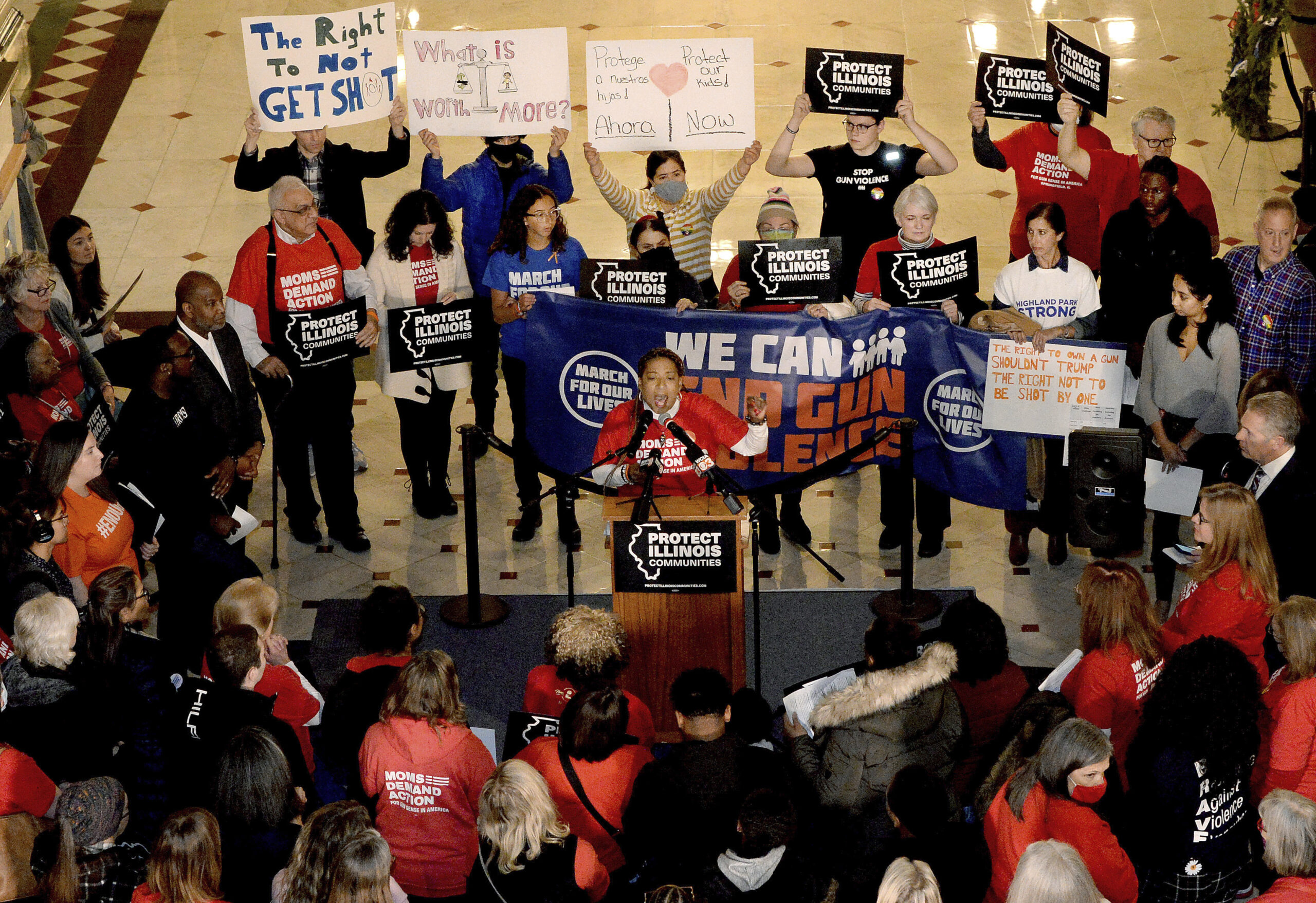Last month, Illinois’ Legislature passed a sweeping gun reform package that aims to keep guns out of the hands of potentially dangerous people. The Protect Illinois Communities Act also ends the sale of assault weapons, high-capacity magazines, and switches, attachments that turn handguns into automatic weapons.
Due in large part to its assault weapons provisions, the law already faces legal pushback, including a temporary restraining order against its implementation. Gun reform advocates see it as a step forward, but have their own concerns about the state’s plans to enforce its provisions, how it will evaluate progress, and what else Illinois can be doing to address the more everyday gun violence plaguing cities like Chicago.
“This was like a capstone policy repair,” said Kathleen Sances, CEO of Illinois’ Gun Violence Prevention PAC. “But honestly, there’s so much work … that we have to keep doing, to make us safer.”
To make sure the law is working, Sances said, the state must keep an eye on implementation to ensure that new policies are not having a disproportionate impact on communities of color. Echoing the language of many researchers and politicians, including Governor J.B. Pritzker, she called gun violence a public health issue that needs solutions that target its root causes. She said officials must help communities escape poverty by providing access to health care, education, and more job opportunities so that people don’t feel pressured to enter the illegal economy. And, she said, the state must continue funding violence intervention efforts and better support survivors.
“There’s outrage at mass shootings,” Sances said. “There’s not outrage about the everyday gun violence.”
In the last decade, Illinois has passed at least 17 policies regulating firearms. The state has set standards on who can obtain a gun, how to carry and store them, which types of guns can be sold, and how to flag gun owners who may pose a danger to themselves or others. State law also addresses illegal gun trafficking, licensing requirements for firearms dealers, the availability of data on weapons used in crimes, and funding for gun violence prevention.
Advocates for gun reform said they have amassed support for these measures in Illinois by uniting different groups that want to prioritize public safety. But it hasn’t been easy.
“The biggest struggle is that there wasn’t a strong enough political voice to counteract the gun industry and lobby,” said Dan Kotowski, president and CEO of Kids Above All, a Chicago-based organization focused on child welfare and education. Advocates must continue to convince policymakers that reform isn’t about attacking the rights of gun owners but rather, creating laws that keep children and families safe.
The issue is still sensitive and unsettled. Sances said there has also been an issue with misinformation, especially regarding language about assault weapons in the newly passed legislation. Some opponents have interpreted the 2023 measure to mean that law enforcement would enter people’s homes and seize their assault weapons, but that isn’t true. Current owners of these weapons can register to keep them through their Firearm Owner’s Identification Card account starting October 1.

Research shows there’s more common ground between gun owners and reform advocates than people think, said Michael Siegel, a firearms researcher and professor at Tufts University School of Medicine. He said the majority of gun owners agree that people who are a danger to themselves or others should not have access to firearms.
Illinois’ new law does largely focus on those shared beliefs. In addition to ending the sale of assault weapons, larger magazines, and switches, it will require the Illinois State Police and other local, state, and federal law enforcement agencies to coordinate investigations into illegal firearm trafficking. It also extends the length of restraining orders that prohibit the use of firearms from six months to one year, with the opportunity to renew for another year. And it requires private firearms sellers to conduct universal background checks through a federally licensed gun dealer or the State Police.
Siegel said assault weapon bans are popular among legislators because they react to the weapons used in mass shootings, but such bans have not been conclusively proven to stop mass shootings or reduce homicide rates. It’s better, he said, to focus on measures that address who has access to weapons that are more likely to be used in everyday shootings. More demonstrably effective, he says, are laws that strengthen rules keeping guns away from people with a history of violence, permitting systems that require thorough background checks, and “red flag” laws that allow family or law enforcement to temporarily remove firearms from people who present a danger to themselves or others.
Siegel said there’s strong evidence that indicates that the history of structural racism is strongly associated with the level of gun violence in a community. He said neighborhoods that have experienced redlining, a racially discriminatory practice that denies housing based on race or ethnicity, have high rates of gun violence even decades after the practice was at its peak.
“Those policies are having an effect today, in terms of increasing rates of homicide among the Black population,” Siegel said. “If you want to really counter that, you have to confront structural racism and you have to work to dismantle [it].”

